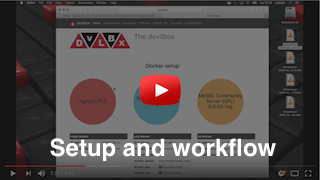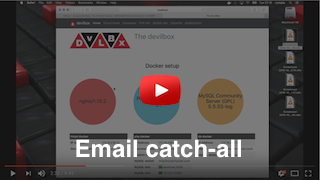Devilbox Documentation
Overview | Quickstart | Install | Update | Configure | Run | Usage | OS | Backups | Examples | Technical | Hacking | FAQ
Overview
- Main idea
- Features
- Supported Host OS
- Requirements
- Docker documentation
- Devilbox documentation
- Video Tutorials
- Available PHP Modules
- Supported Frameworks and CMS
1. Main idea
The devilbox allows you to have an unlimited number of projects ready without having to install any external software and without having to configure any virtual hosts. As well as providing a very flexible development stack that you can run offline. (Internet is only required to initially pull docker container).
The only thing you will have to do is to create a new folder on the filesystem and your virtual host is ready to be served with your custom domain.
The default project catch-all domain is *.loc (see Configure for how to change it). Let's view an example:
# Inside your main project folder
$ ls -l
drwxr-xr-x 3 cytopia 4096 Jun 10 13:10 my-drupal
drwxr-xr-x 3 cytopia 4096 Jun 10 13:10 my-wordpress
drwxr-xr-x 3 cytopia 4096 Jun 10 13:10 project1
drwxr-xr-x 3 cytopia 4096 Jun 10 13:10 project2
drwxr-xr-x 3 cytopia 4096 Jun 10 13:10 yii-test
By having the above folders, the devilbox will automatically be able to serve the following vhosts:
- http://my-drupal.loc
- http://my-wordpress.loc
- http://project1.loc
- http://project2.loc
- http://yii-test.loc
New folders can be created, deleted and removed during run-time and corresponding virtual hosts will be available instantly without having to restart anything.
2. Features
| Feature | Description |
|---|---|
| Internet | |
| No always-on | Internet connection is only required during initial setup or update (to pull containers), afterwards you can always work offline. |
| Projects | |
| Unlimited Projects | Add as many Projects as you need. |
| Auto VirtualHosts | New VirtualHosts are added instantly without a restart or reload. Just create a new directory and you are ready to go. |
| Auto DNS | Use the built-in DNS server to stop worrying about /etc/hosts setup per project. |
| Email catch-all | All outgoing emails are intercepted and stored locally. Use the intranet to view any sent email. |
| Custom VirtualHost domains | Whatever project domain you desire: *.dev, *.loc, *.local or even subdomains like *.sub.example - you can adjust it to your needs. |
| Run | |
| Selective start | Run only the Docker container you actually need. |
| Version choice | Use your development stack with whatever version combination needed. |
| Stack choice | Attach SQL or NoSQL container and use Nginx or Apache to simulate your live env. |
| Log files | Log files are available for each chosen version. |
| Configuration | |
| HHVM | You can choose between PHP 5.6 and PHP 7 mode for HHVM |
| php.ini | You an overwrite PHP settings for each PHP version. |
| Custom PHP modules | You can add any custom PHP modules without having to rebuild the Docker container. |
| my.cnf | You an overwrite MySQL settings for each MySQL version. |
| Intranet | |
| phpMyAdmin | Manage your MySQL databases here. |
| Adminer | Manage your SQL and NoSQL databases here. |
| OpCacheGUI | Visualize the state of opcache usage. |
| EmailGUI | See all sent emails at a glance |
| Docker Tools | |
| Work inside container | You can completely work inside the PHP container and use all bundled tools in order to keep your host system clean. |
| Hacking | |
| Add custom container | You can add any other Docker container to docker-compose.yml and start using them in your development stack. |
3. Supported Host OS
The devilbox runs on all major operating systems. Below you can quickly check the recommended docker versions and current issues per OS.
| Docker Version | normal | Docker for Windows | Docker for Mac |
| Current Issues | here | here | here |
How about FreeBSD?
The devilbox has not been tested on FreeBSD yet. Current milestones include to make it rock-solid on the above listed operating systems. However, if you want it to run on FreeBSD open up an issue on Github and you will receive support making it work on FreeBSD.
4. Requirements
- Internet connection - only required during initial setup for cloning the devilbox repository and pulling the required docker container. Afterwards you can always work offline.
- Docker Engine 1.12.0+
- Docker Compose 1.9.0+
- On Windows use Docker for Windows (not tested on Docker Toolbox)
- On OSX use Docker for Mac (not tested on Docker Toolbox)
5. Docker documentation
If you have never worked with docker/docker-compose before, you should check up on their documentation to get you started: docker docs.
6. Devilbox documentation
| Topic | Description |
|---|---|
| Quickstart | Command overview to get you started quickly |
| Install | How to install docker, docker-compose and the devilbox |
| Update | Update best practise |
| Configure | How to configure the devilbox, switch versions (PHP, MySQL, PgSQL, ...) and how to set custom options (php.ini, my.cnf, httpd.conf, ...) |
| Run | How to operate the devilbox, start and stop all or only required Docker container. |
| Usage | How to create projects, Email and DNS usage, tools (composer, npm, node, drush, ...), entering the container, Log files, Xdebug, Backups, Intranet, ... |
| OS | Operating System differences between Linux, Windows and OSX. |
| Backups | How to backup and restore your databases for different versions. |
| Examples | Some project examples for popular CMS/Frameworks. How to setup Wordpress, Drupal, Yii, ... |
| Technical | Technical background information |
| Hacking | How to extend the devilbox with your own docker container |
| FAQ | Questions and Troubleshooting |
7. Video Tutorials
Have a look at youtube to see some the features in action.
8. Available PHP Modules
The devilbox is a development stack, so it is made sure that a lot of PHP modules are available out of the box in order to work with many different frameworks.
apc, apcu, bcmath, bz2, calendar, Core, ctype, curl, date, dom, ereg, exif, fileinfo, filter, ftp, gd, gettext, gmp, hash, iconv, igbinary, imagick, imap, intl, json, ldap, libxml, magickwand, mbstring, mcrypt, memcache, memcached, mhash, mongodb, msgpack, mysql, mysqli, mysqlnd, openssl, pcntl, pcre, PDO, pdo_mysql, pdo_pgsql, pdo_sqlite, pgsql, phalcon, Phar, posix, pspell, readline, recode, redis, Reflection, session, shmop, SimpleXML, soap, sockets, SPL, sqlite3, standard, sysvmsg, sysvsem, sysvshm, tidy, tokenizer, uploadprogress, wddx, xdebug, xml, xmlreader, xmlrpc, xmlwriter, xsl, Zend OPcache, zip, zlib
There will however be slight differences between the versions and especially with HHVM. To see the exact bundled modules for each version visit the corresponding docker repositories on Github:
PHP 5.4 | PHP 5.5 | PHP 5.6 | PHP 7.0 | PHP 7.1 | PHP 7.2 | HHVM
** Custom PHP Modules**
Apart from asking for new modules to be bundled with each Docker container, you can simply also just place any missing modules into mod/(php-fpm|hhvm)-<VERSION> and add a custom *.ini file to load them. See Custom PHP Modules in the Configuration documentation for how to do that in two simple steps.
9. Supported Frameworks and CMS
As far as tested there are no limitations and you can use any Framework or CMS just as you would on your live environment. Below are a few examples of extensively tested Frameworks and CMS:
Have a look at Examples for how to set them up on the devilbox.









